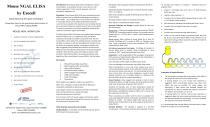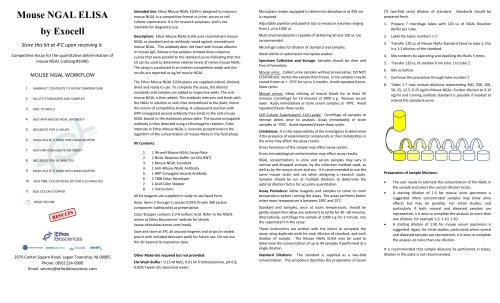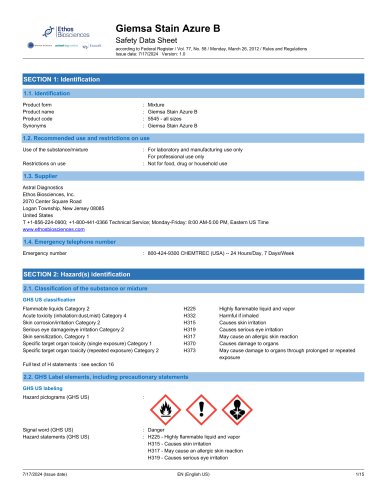
Catalog excerpts

Store this kit at 4oC upon receiving it. Competitive Assay for the quantitative determination of mouse NGAL (catalog #1040) MOUSE NGAL WORKFLOW 1. WARM KIT CONTENTS TO ROOM TEMPERATURE 2. DILUTE STANDARDS AND SAMPLES 4. ADD ANTI-MOUSE NGAL ANTIBODY 6. WASH PLATE 3 TIMES WITH WASH BUFFER 9. WASH PLATE 5 TIMES WITH WASH BUFFER 10. ADD TMB, COLOR DEVELOP FOR 5-20 MINUTES 2070 Center Square Road, Logan Township, NJ 08085 Phone: (856) 224-0900 Email: service@ethosbiosciences.com Intended Use: Ethos Mouse NGAL ELISA is designed to measure mouse NGAL in a competitive format in urine, serum or cell culture supernatant. It is for research purposes, and is not intended for diagnostic use. Description: Ethos Mouse NGAL ELISA uses recombinant mouse NGAL as standard and an antibody raised against recombinant mouse NGAL. This antibody does not react with mouse albumin or mouse IgG. Mouse urine samples showed dose-response curves that were parallel to the standard curve indicating that this kit can be used to determine relative levels of native mouse NGAL. The assay is conducted in an indirect competitive mode and the results are reported as ng/ml mouse NGAL. The Ethos Mouse NGAL ELISA plates are supplied coated, blocked, dried and ready to use. To complete the assay, the diluted standards and samples are added to respective wells. The antimouse NGAL is then added. This antibody interacts and binds with the NGAL in solution or with that immobilized to the plate, hence the notion of competitive binding. A subsequent reaction with HRP-conjugated second antibody then binds to the anti-mouse NGAL bound to the stationary phase plate. The bound conjugated antibody is then detected using a chromogenic reaction. Color intensity in Ethos Mouse NGAL is inversely proportional to the logarithm of the concentration of mouse NGAL in the fluid phase. 1. 1 96-well Mouse NGAL Assay Plate 2. 2 NGAL Reaction Buffer (or DILUENT) 3. 1 Mouse NGAL Standard 4. 1 Anti-Mouse NGAL Antibody 5. 1 HRP Conjugate Second Antibody 7. 1 Acid Color Stopper All kit reagents are supplied in ready to use liquid form. Note: Items 2 through 5 contain 0.05% Proclin 300 (active component Isothiazolin) as preservative. Color Stopper contains 2.0 N Sulfuric Acid. Refer to the MSDS online at Ethos Biosciences' website for details (www.ethosbiosciences.com/msds). Save and store at 4°C all unused reagents and strips (in sealed pouch with included desiccant pack) for future use. Do not use this kit beyond its expiration date. Other Materials required but not provided: EI A Wash Buffer: 0.15 M NaCl, 0.01 M Triethanolamine, pH 6.8, 0.05% Tween 20, deionized water. Microplate reader equipped to determine absorbance at 450 nm is required. Adjustable pipettes and pipette tips to measure volumes ranging from 1 ul to 1000 ul. Multi-channel pipettors capable of delivering 50 and 100 uL are recommended. Microfuge tubes for dilution of standard and samples. Wash bottle or automated microplate washer. Specimen Collection and Storage: Samples should be clear and free of hemolysis. Mouse urine: Collect urine samples without preservative. DO NOT CENTRIFUGE. Vortex the sample then freeze. Urine samples may be stored frozen at < -70°C for up to 2 months. Avoid repeated freeze-thaw cycles. Mouse serum: Allow clotting of mouse blood for at least 30 minutes. Centrifuge for 10 minutes at 1000 x g. Recover serum layer. Assay immediately or store serum samples at -70°C. Avoid repeated freeze-thaw cycles. Cell Culture Supernatant/ Cell Lysate: Centrifuge all samples to remove debris prior to analysis. Assay immediately or store samples at -70°C. Avoid repeated freeze-thaw cycles. Limitations: It is the responsibility of the investigator to determine if the presence of experimental compounds or their metabolites in the urine may affect the assay results. Gross hemolysis of the sample may affect assay results. Gross microbiological contamination may affect assay results. NGAL concentrations in urine and serum samples may vary in normal and diseased animals, by the collection method used, as well as by the mouse strain and sex. It is recommended to use the same mouse strain and sex when designing a research study. Samples should be run at multiple dilutions to determine the optimal dilution factor for accurate quantitation. Assay Procedure: Allow reagents and samples to come to room temperature before running the assay. The assay performs better when room temperature is between 18°C and 25‘C. Standard and Samples, once at room temperature, should be gently mixed then allow any sediment to settle for 30 - 60 minutes. Alternatively, centrifuge the sample at 1000 x g for 1 minute. Use the supernatant in the assay. These instructions are written with the intent to complete the assay using duplicate wells for each dilution of standard, and each dilution of sample. The Mouse NGAL ELISA may be used to determine the concentration of up to 40 samples if performed at a single dilution. Standard Dilutions: The standard is supplied as a two-fold concentration. This procedure describes the preparation of seven (7) two-fold serial dilution of standard. Standards should be prepared fresh. 1. Prepare 7 microfuge tubes with 120 uL of NGAL Reaction Buffer per tube. 2. Label the tubes numbers 1-7. 3. Transfer 120 uL of Mouse NGAL Standard Stock to tube 1; this is a 1:2 dilution of the standard. 4. Mix contents by aspirating and expelling the fluids 5 times. 5. Transfer 120 uL of solution from tube 1 to tube 2. 7. Continue this procedure through tube number 7. 8. Tubes 1-7 now contain dilutions representing 400, 200, 100, 50, 25, 12.5, 6.25 ng/ml Mouse NGAL. Further dilution to 3.12 ng/ml and running undilute standard is possible if needed to extend the standard curve. Preparation of Sample Dilutions: • The user needs to estimate the concentration of the NGAL in the sample and select the correct dilution factor. • A starting dilution of 1:5 for mouse urine specimens is suggested. More concentrated samples may show urine effects but may be possible. For initial studies, and particularly if both normal and diseased samples are represented, it is wise to complete the analysis at more than one dilution, for example 1:5, 1:10, 1:20. • A starting dilution of 1:50 for mouse serum specimens is suggested. Again, for initial studies, particularly when normal and diseased samples are represented, it is wise to complete the analysis at more than one dilution. It is recommended that sample dilutions be performed in tubes; dilution in the plate is not recommended.
Open the catalog to page 1All Ethos Biosciences catalogs and technical brochures
-
Giemsa Stain Azure B
15 Pages


